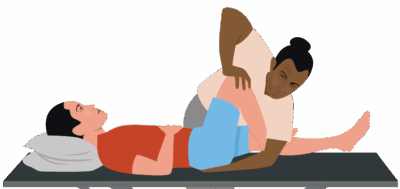Thigh Thrust Test
The Thigh Thrust Test (also called the Posterior Shear Test) is an orthopedic provocation maneuver used to screen for sacroiliac joint (SIJ) dysfunction or pain by applying a targeted shearing force across the SI joint. It is especially useful in identifying whether SIJ pathology is contributing to a client’s low back, buttock, or pelvic pain.
How is the Test Performed
-
Client position: Supine (lying on the back) with the hip and knee of the tested side flexed to 90° and slight adduction.
-
The therapist stands on the side to be tested and places one hand over the sacrum to stabilize the pelvis.
-
The examiner then applies a linearly increasing anteroposterior force (downward push) along the femur, generating a shearing stress through the SIJ.
-
The maneuver can be repeated 3 to 6 times or as a continuous pressure.
-
A positive test: Reproduction of the client’s typical SIJ region pain during pressure.
Clinical Significance
-
The Thigh Thrust Test has good sensitivity (~88%) and moderate specificity (~69%) for detecting SIJ dysfunction.
-
It is best used as part of a multi-test cluster (usually including FABER, Gaenslen, Compression, and Distraction tests); the likelihood of SIJ pathology increases as more tests are positive.
-
Pain provoked by this maneuver that matches the client’s symptoms strongly suggests the SIJ as the pain source; but the absence of pain does not conclusively rule out SIJ issues.
Assessment
-
Use the Thigh Thrust Test for clients with low back, buttock, or pelvic pain where SIJ involvement is possible.
-
Always compare both sides (even if symptoms are unilateral) and document pain intensity, location, and whether it matches the client’s typical complaint.
-
Remember that the Thigh Thrust Test is only one part of a broader SIJ assessment.
Treatment
-
If positive:
-
Avoid deep tissue work, high-velocity manipulation, or forceful stretching or mobilization directly over the SIJ.
-
Focus on gentle soft tissue therapy to surrounding gluteals, lower back, and pelvic stabilizers, and pain-modifying approaches.
-
Educate clients about pelvic stability, proper lifting, posture, and activity modification to minimize SIJ shearing and aggravation.
-
Refer to other health professionals for persistent, severe, or complex SIJ pain, or when medical imaging or a multidisciplinary approach is indicated.
-
Safety and Referral
-
Always refer clients for further evaluation if red flag symptoms, severe or persistent SIJ pain, or associated neurological symptoms are present.
-
Collaborate with physiotherapists, physicians, and other relevant professionals for complex or non-resolving cases.

